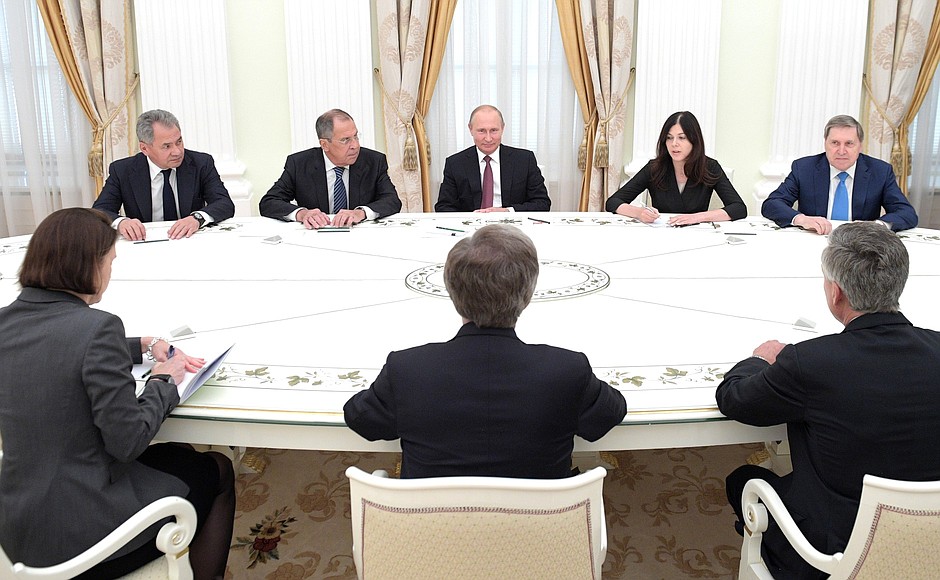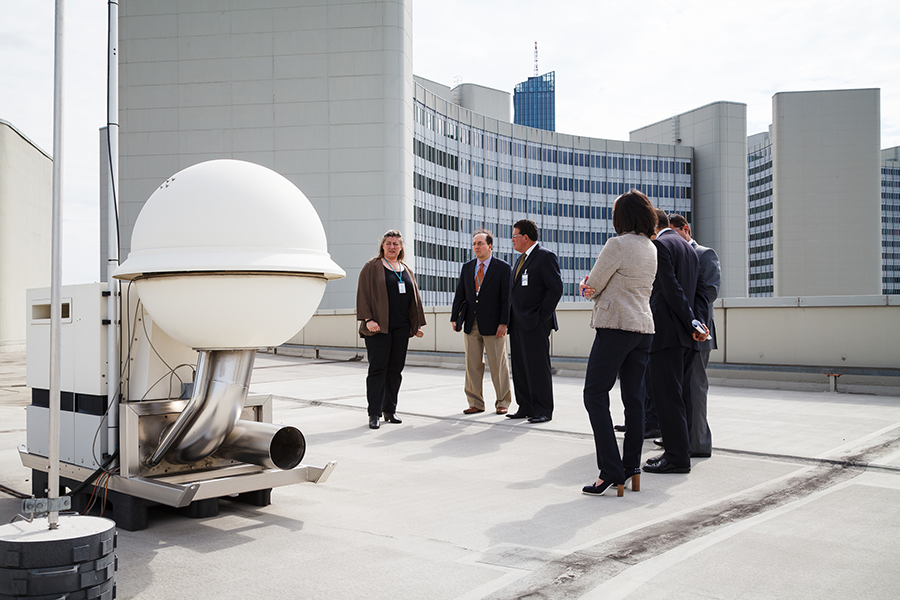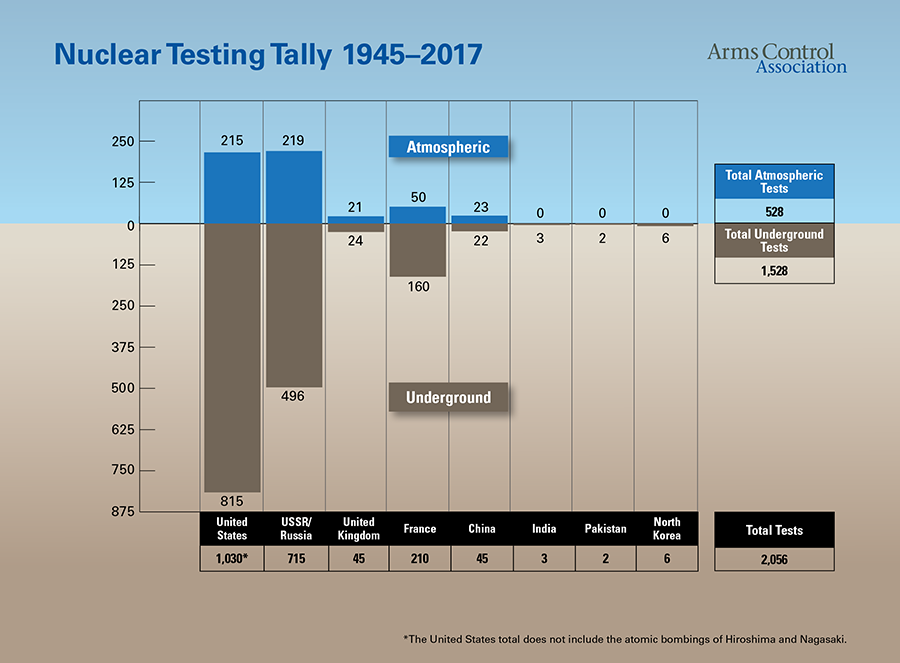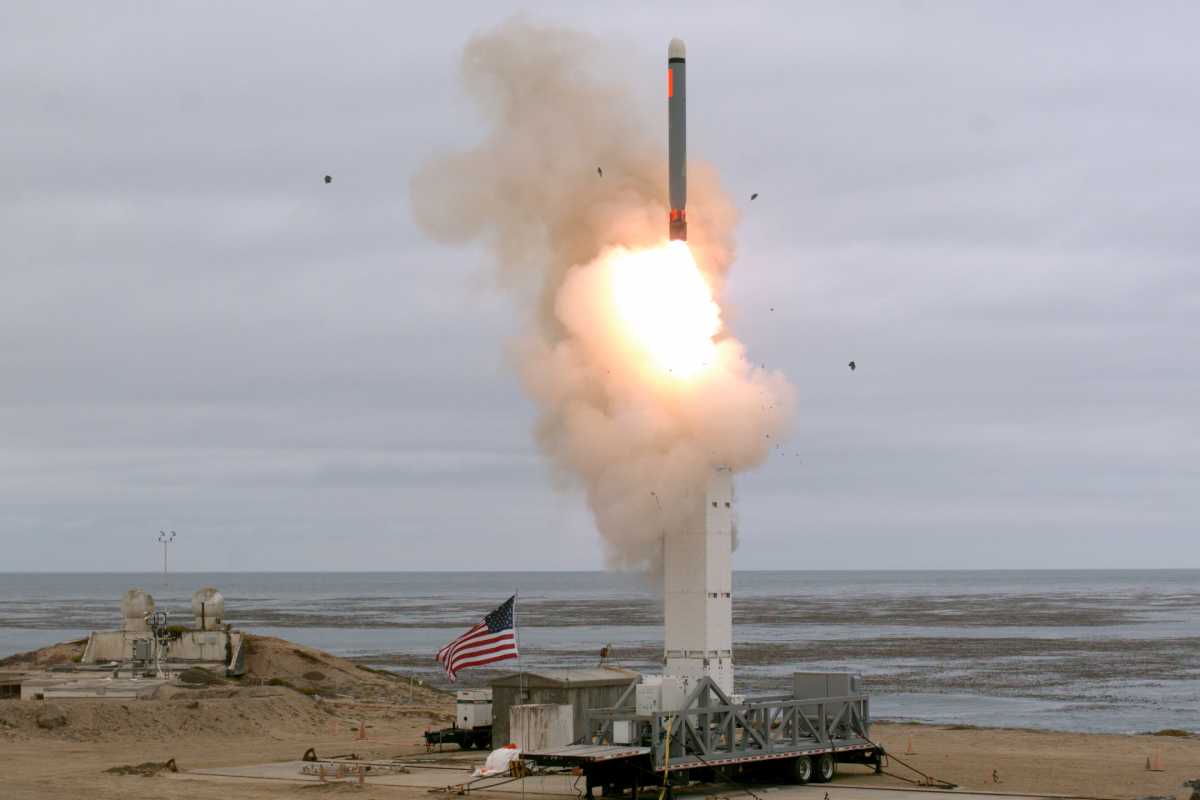U.S. Tests Ground-Launched Cruise Missile
On Aug. 18, less than two weeks after the official collapse of the 1987 Intermediate-Range Nuclear Forces (INF) Treaty, the United States tested a ground-launched variant of the Tomahawk sea-launched cruise missile that would have been prohibited by the treaty. The test was a clear signal that the United States can and will pursue such systems in the absence of the INF Treaty.
In a statement, the Defense Department said the “test missile exited its ground mobile launcher and accurately impacted its target after more than 500 kilometers of flight. Data collected and lessons learned from this test will inform the Department of Defense's development of future intermediate-range capabilities.”
The launcher used in the test—the MK-41 vertical launching system—is the same one, though in a different configuration, that is currently fielded in Romania and is soon to be deployed in Poland as part of NATO’s Aegis Ashore missile defense system. Russia has long claimed that this launcher was a violation of the INF Treaty. However, the U.S. government has repeatedly stated that the system “does not have an offensive ground-launched ballistic or cruise missile capability.”
The U.S.-Soviet INF Treaty banned the possession or testing of all nuclear and conventional ground-launched ballistic and cruise missiles with ranges between 500 and 5,500 kilometers.
Russia said the recent U.S. test vindicated Moscow’s charge that the MK-41 launchers fielded in Europe violated the treaty.
“The Americans stubbornly rejected this,” Russian President Vladimir Putin said at a meeting with his security council Aug. 23, “claiming that the ground-based MK-41 was allegedly unable to launch Tomahawk sea-based cruise missiles. Now the fact of the violation is evident, and impossible to dispute.”
Putin stated that in light of the test and comments from U.S. officials calling for the deployment of new intermediate-range missiles, “I instruct the Defense Ministry, the Foreign Ministry and other competent agencies to analyze the level of threat posed to our country by the above actions of the United States, and take exhaustive measures for a reciprocal response.”
More recently, on Sept. 5, Putin said, “We will produce such [ground-launched intermediate-range] missiles, of course, but we will not deploy them in the regions where no ground-based missile systems of this class manufactured by the U.S. have emerged.”
China also expressed its concerns about the U.S. test. Chinese Foreign Ministry spokesman Geng Shuang said Aug. 20, “We advise the U.S. side to abandon outdated notions of Cold War thinking and zero-sum games, and exercise restraint in developing arms.”
At the request of Russia and China, the United Nations Security Council met Aug. 22 to discuss the collapse of the treaty and the U.S. missile test.
Russia's First Deputy Permanent Representative to the UN Dmitry Polyanskiy said that “because of the U.S.'s geopolitical ambitions, we are all one step from an arms race that cannot be controlled or regulated in any way.”
Acting U.S. Ambassador to the UN Jonathan Cohen responded by saying, “We are here today because the Russian Federation preferred a world in which the United States continued to fulfill its INF Treaty obligations, while the Russian Federation did not.”
The Trump administration’s push for new intermediate-range missiles has been controversial in Congress. The House version of the fiscal year 2020 National Defense Authorization Act (NDAA) would prohibit the Pentagon from spending money to develop new missiles until it meets several conditions. The Senate version does not have a similar provision, and the two versions are set to be reconciled in the coming weeks.
In addition to the test of a ground-launched cruise missile, the Defense Department is also planning to test later this year an intermediate-range ballistic missile with a range of about 3,000 to 4,000 kilometers. Robert Soofer, deputy assistant secretary of defense for nuclear and missile defense policy, confirmed at a conference in Virginia on Sept. 4 that the department is planning to test a ballistic missile, but would not comment on what missile would be tested. —KINGSTON REIF, director for disarmament and threat reduction policy, and SHANNON BUGOS, research assistant
Bolton Dismissal Could Affect New START
The departure of John Bolton as National Security Advisor Sept. 10 could affect the Trump administration’s internal deliberations about the future of the 2010 New Strategic Arms Reduction Treaty (New START). President Trump tweeted that he had asked for Bolton’s resignation, citing disagreements with many of Bolton’s suggestions.
 Bolton, long an opponent of the treaty, stated in June that while “no decision” has yet been made, New START is “unlikely” to be extended. Bolton, who had been the administration’s point person on relations with Russia, said that the administration would instead focus on negotiating a more comprehensive agreement that captures additional types of Russian nuclear weapons not limited by the treaty and includes China.
Bolton, long an opponent of the treaty, stated in June that while “no decision” has yet been made, New START is “unlikely” to be extended. Bolton, who had been the administration’s point person on relations with Russia, said that the administration would instead focus on negotiating a more comprehensive agreement that captures additional types of Russian nuclear weapons not limited by the treaty and includes China.
Whether the administration will continue to focus on trying to achieve a broader deal at the expense of focusing on a five-year extension of New START remains to be seen. The United States and Russia last met to discuss strategic security issues in mid-July.
New START caps the deployed U.S. and Russian strategic nuclear arsenals at 1,550 warheads, 700 missiles and heavy bombers, and 800 missile launchers and bombers. Though set to expire Feb. 5, 2021, the treaty can be extended for up to five years by agreement of the U.S. and Russian presidents.
Putin said on Sept. 5 that “So far, our American partners have remained silent with regard to our proposals to maintain contacts in the sphere of disarmament and containing the arms race.”
Before Bolton’s departure, officials continued to provide vague updates about the status of the administration’s approach to arms control and raise concerns about extending New START.
In an Aug. 13 briefing, Andrea Thompson, undersecretary of state for arms control and international security, said, “We’ve worked very strongly within our interagency and have recently had discussions with the Russian Federation on arms control.” She said the two sides discussed “what systems they’ve developed or are developing would fall into the New START Treaty parameters and quite candidly, those that won’t.” Thompson further emphasized the administration’s desire to have China be a part of those discussions.
Meanwhile, Defense Secretary Mark Esper commented in an Aug. 22 interview with Fox News that Russia is “trying to expand their strategic nuclear arsenal…to deal with the United States.” Therefore, he said, “as people talk about a New Strategic Arms Reduction Treaty—that’s why we say, look, if there’s going to be an extension of New START, then we need to make sure we include all of these new [strategic-range] weapons that…Russia is pursuing.”
When asked about the future of New START at a Sept. 6 event in Washington, Chairman of the Joint Chiefs of Staff Gen. Joseph Dunford stated, “I would be in favor of extending the agreement provided all parties were going to comply...It's difficult for me right now in the wake of the violation of the INF Treaty to say automatically that I support extending START.”
Senators Express Support for New START Extension
Eighteen U.S. senators—led by Sen. Elizabeth Warren (D-Mass.)—sent a letter Aug. 21 to Senate Armed Services Committee Chairman James Inhofe (R-Okla.) and Ranking Member Jack Reed (D-R.I.) urging an extension of New START.
“Not only does New START provide much needed nuclear stability, it also affords the United States with invaluable insight into Russia's nuclear arsenal,” the senators wrote. “Without New START, the intelligence community would have to divert intelligence assets to attempt to maintain the same level of insight into Russia’s strategic forces.”
The group of senators called for retaining a provision in the House version of the fiscal year 2020 NDAA expressing the sense of Congress that the United States should extend New START. The House bill also prohibits the use of funds to withdraw from the treaty unless Russia is in material breach of the agreement; requires the director of national intelligence and the secretaries of state and defense to issue reports on the consequences of the treaty’s lapse; and requires presidential certification in advance of New START’s expiration.
“Without New START,” the senators said, “there would be no limits on U.S. and Russian strategic nuclear forces for the first time in nearly 50 years. The risk of unconstrained nuclear competition would grow.”
In addition, Senate Foreign Relations Committee Ranking Member Sen. Robert Menendez (D-N.J.) and House Armed Services Committee Chairman Rep. Adam Smith (D-Wash.) on Sept. 9 sent a letter to the director of the Congressional Budget Office requesting that the agency analyze the consequences of President Trump allowing New START to expire in 2021.
The lawmakers said the “analysis should consider several scenarios in which the United States increases the size of its strategic nuclear arsenal, either in response to a Russian increase of the same amount or as a hedge against the uncertainty about whether Russia might be increasing the capabilities of its forces quantitatively or qualitatively.”
Russian Weapons Explosion Sparks Nuclear Concerns
An explosion off the coast of Russia in the White Sea prompted questions about Moscow’s development of a new generation of strategic nuclear weapons.
 The Aug. 8 incident began with a blast at the Nenoksa Missile Test Site, which is on the coast of the White Sea. Russian authorities afterward decided to close part of the sea to civilians for a month.
The Aug. 8 incident began with a blast at the Nenoksa Missile Test Site, which is on the coast of the White Sea. Russian authorities afterward decided to close part of the sea to civilians for a month.
According to a statement from Russia’s State Atomic Energy Corporation (Rosatom) two days later, five employees died as a result of the test which involved “isotopic sources of fuel on a liquid propulsion unit.” Two military personnel also reportedly died from the blast.
Russia’s state weather agency, Rosgidromet, reported Aug. 13 that radiation levels in a nearby city, Severodvinsk, spiked after the accident. That same day, the Russian military reportedly told Nenoksa residents to evacuate, but the order was canceled just hours later. On Aug. 26, Rosgidromet further reported that it found radioactive isotopes in test samples after the explosion.
U.S. nuclear experts and intelligence officials assessed that the accident likely involved a failed test by Russia of a nuclear-powered cruise missile—a technology that the United States long ago discarded as expensive, impractical, and dangerous.
Kremlin spokesperson Dmitry Peskov appeared to confirm this assessment Aug. 21, reportedly stating that a “nuclear-propelled missile” was being tested at the time of the accident.
To date, Putin has not mentioned what weapon was being tested at Nenoksa. At first, he only said that experts on the scene were “controlling the situation” and that “measures are being taken to ensure that there is nothing unexpected.” Putin later commented, “This is work in the military field, work on promising weapons systems. We are not hiding this.”
In a March 2018 speech, Putin touted Russia’s development of several new long-range nuclear delivery systems. These included a new missile—dubbed the 9M730 Buresvestnik by Russia and the SSC-X-9 Skyfall by NATO—that Putin boasted had “unlimited range” and was “invincible against all existing and prospective missile defense and counter-air defense systems.” Putin claimed that Russia had successfully tested the missile in late 2017.
Reacting to the incident, Trump tweeted Aug. 12, “The United States is learning much from the failed missile explosion in Russia. We have similar, though more advanced, technology. The Russian ‘Skyfall’ explosion has people worried about the air around the facility, and far beyond. Not good!” There is no evidence that the United States is developing any nuclear-powered missiles.
A later CNBC report, however, stated that a U.S. intelligence assessment determined the explosion was caused by a recovery mission to salvage a nuclear-powered cruise missile from the ocean floor from a previous test.
Other analysts suggested the weapon from the Aug. 8 incident could have been a conventional rocket coupled with a radioisotope thermal generator, a technology that has been used successfully for decades to produce small amounts of electricity for spacecraft or remotely located scientific equipment.
A Sept. 11 CNBC report cited an intelligence finding that despite numerous test failures, Russia’s new nuclear-powered cruise missile would be ready for deployment in 2025, about five years earlier than an earlier assessment.
Further complicating the situation was the Comprehensive Test Ban Treaty Organization (CTBTO) reporting that some Russian radionuclide sensor stations began to halt transmissions of data two days after the accident. The CTBTO’s global network of sensors to detect nuclear explosions includes 80 radionuclide stations that monitor for by-products of nuclear fission and fusion. Russia has contributed seven such stations to the network. Yet, by Aug. 13, five stations—Dubna, Kirov, Bilibino, Zalesovo, and Peleduy—had gone silent. On Aug. 20, the CTBTO reported that Bilibino and Peleduy were back online and backfilling data.
In response to the CTBTO’s revelations, Deputy Foreign Minister Sergei Ryabkov said that “data transmission from stations of the national segment of the international monitoring network is strictly voluntary for any country.” Secretary of State Mike Pompeo commented, “We expect every country to live up to every one of its obligations with respect to reporting should there be an incident that relates to their nuclear activities.”
For more information, see “Russian Weapons Accident Raises Nuclear Concerns,” in Arms Control Today, September 2019.
Putin Offers to Sell Hypersonic Weapon to the United States
Putin said at the Eastern Economic Forum on Sept. 5 that he broached the possibility of selling some of Russia’s next generation of nuclear delivery systems to the United States to pave the way for talks to limit those weapons.
“Most recently, we met with our U.S. partners in Osaka, and also raised the question about how we can include our latest weapons, including hypersonic strike missile systems, in a general agreement,” Putin said. “I mean no other country, including the United States, has such weapons.”
Putin continued: “I told Donald: ‘If you want, we can sell it to you and thus balance out everything in one go.’ Truth be told, they are saying they will soon start making it themselves. Perhaps, they will. But why spend money when we have already spent it and can get something from them without jeopardizing our security, but with an eye towards creating a situation of balance?”
Russia’s new strategic delivery systems under development include the 9M730 Buresvestnik, Avangard hypersonic glide vehicle, Kinzhal air-launched ballistic missile, and Poseidon undersea autonomous drone.
Lieutenant-General Viktor Poznikhir, first deputy head of the Russian general staff’s main operational department, said in July that the Avangard hypersonic weapon would be captured by New START.
“The Avangard missile system with the boost glide vehicle is due to enter service and assume combat duty by the end of the year,” he said. “Considering that the Avangard system is equipped with an intercontinental ballistic missile, it will be subject to all the procedures stipulated by the strategic offensive arms reduction treaty.”
U.S. Issues 2019 Arms Control Compliance Report
On Aug. 22, the State Department released its annual report on Adherence to and Compliance with Arms Control, Nonproliferation, and Disarmament Agreements and Commitments.
Primarily covering activities during 2018, the report determined that “the United States continued to be in compliance with all of its obligations under arms control, nonproliferation, and disarmament agreements and commitments.”
Regarding the INF Treaty, the report stated that Russia continued to be in violation of the agreement, which prompted the Trump administration to withdraw from the treaty Aug. 2, 2019.
Since 2014, the United States has accused Russia of violating the treaty by testing, possessing, and fielding an illegal ground-launched cruise missile, known as the 9M729. The report asserts that Russia began development of the missile “probably by the mid-2000s” and concluded in 2015 “a comprehensive flight test program.” By the end of 2018, Russia fielded multiple battalions of the 9M729.
“The United States assesses that Russia’s decision to violate the INF Treaty was born out of years of frustration with being prohibited from possessing ground-launched intermediate-range missiles even as perceived threats within these ranges were increasing around its borders,” the report states.
The compliance report also raises concerns about alleged Russian nuclear weapons testing and compliance with the Threshold Test Ban Treaty (TTBT), which prohibits nuclear tests having a yield exceeding 150 kilotons. The report states: “Based on available information, Russian activities during the 1995-2018 timeframe raise questions about Russia’s compliance with its TTBT notification obligation."
Echoing comments earlier this year from Defense Intelligence Agency Director Lt. Gen. Robert Ashley, the report states: “The United States, including the Intelligence Community, has assessed that Russia has conducted nuclear weapons tests that have created nuclear yield.” In apparent attempt to back up this statement, the report adds that, “During the 1995-2018 timeframe, Russia probably conducted nuclear weapons-related tests at the Novaya Zemlya Nuclear Test Site.”
For more information, see “U.S. Claims of Illegal Russian Nuclear Testing: Myths, Realities, and Next Steps,” by Daryl Kimball, executive director of the Arms Control Association.
FACT FILE

| Sept. 17-30 | 74th session of the UN General Assembly |
| Sept. 25 | 11th Conference on Facilitating the Entry into Force of the CTBT |
| Oct. 7-Nov. 8 | 74th Session of UN First Committee |
| Oct. 24-30 | UN Disarmament Week |
| Nov. 7-9 | The Moscow Nonproliferation Conference, Moscow |
| Dec. 3-4 | NATO Heads of State and Government Meeting, London |
- “Are We Headed for Another Expensive Nuclear Arms Race? Could Be.,” by Steven Erlanger, The New York Times, Aug. 8, 2019
- “Intermediate-Range Missiles are the Wrong Weapon for Today’s Security Challenges,” by Tom Countryman and Kingston Reif, War on the Rocks, Aug. 13, 2019
- “Bringing Russia’s New Nuclear Weapons Into New START,” by Pranay Vaddi, Lawfare, Aug. 13, 2019
- “If Trump ends another nuclear treaty, it will be the height of folly,” by Michèle Flournoy and Kingston Reif, CNN, Aug. 19, 2019
- “Sunday’s US Missile Launch, Explained.,” by Hans M. Kristensen and Matt Korda, Federation of American Scientists, Aug. 20, 2019
- “The Absurd Strategy Behind Russia’s Nuclear Explosion,” by Ankit Panda, The New Republic, Aug. 21, 2019
- “How Congress Can Prevent a Meltdown of Global Nuclear Arms Control,” by Tom Countryman and Laura Kennedy, The National Interest, Aug. 24, 2019
- “The Pentagon’s New Missile Drive Is Bringing Armageddon Closer,” by Michael T. Klare, The Nation, Aug. 30, 2019
- “Russian Weapons Accident Raises Nuclear Concerns,” by Greg Webb, Arms Control Today, Sept. 2019
- “The Last Nuclear Arms Treaty,” Pranay Vaddi, Nicholas Blanchette, and Garrett Hinck, Carnegie Endowment for International Peace

